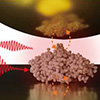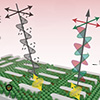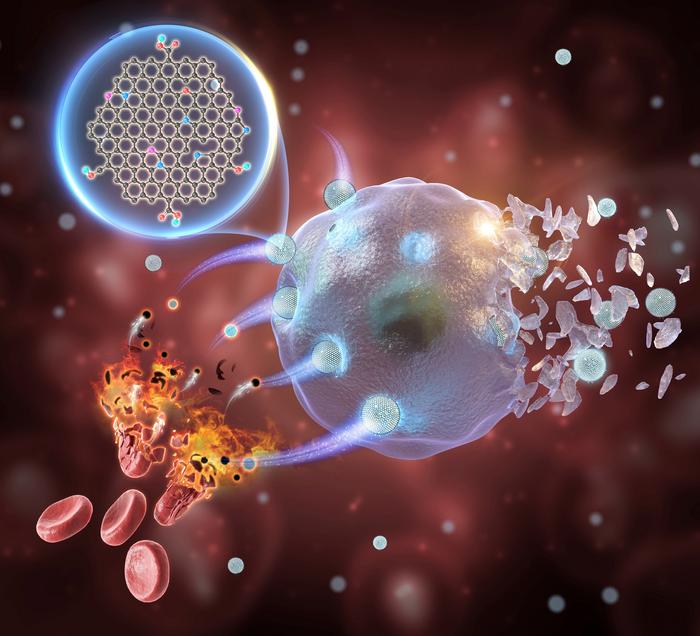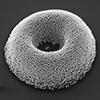Jan 11, 2024 (Nanowerk News) Spin-orbit torque (SOT), an important phenomenon for developing ultrafast and low-power spintronic devices, can be enhanced through Berry phase monopole engineering at high temperatures, shown in a new study by Tokyo Tech researchers. In this study, the temperature dependence of the intrinsic spin Hall effect...
Observing single protein with infrared nanospectroscopy
Jan 10, 2024 (Nanowerk News) Infrared vibrational spectrum of a single protein is observed using advanced measurement techniques based on near-field optical microscopy. This method utilizes light confined at the nanometer scale, allowing for the detailed analysis of extremely small samples, which was previously challenging with conventional infrared spectroscopy. The...
Anisotropic plasmon engineering unlocks multilevel polarised upconversion
Jan 10, 2024 (Nanowerk News) National University of Singapore (NUS) researchers have introduced an upconversion plasmonphore platform to enable precise control over the polarisation of isotropic upconversion nanoparticles (UCNPs). This is achieved by coupling upconversion activators with carefully designed anisotropic gap plasmon mode-supported metasurfaces. Photon-plasmon coupling in hybrid systems is...
Supernovae give rise to black holes or neutron stars
Jan 10, 2024 (Nanowerk News) Scientists have found a direct link between the explosive deaths of massive stars and the formation of the most compact and enigmatic objects in the Universe: black holes and neutron stars. With the help of the European Southern Observatory’s Very Large Telescope (ESO’s VLT), an...
AI helps whittle down candidates for hydrogen carriers in liquid form from billions to about 40
Jan 10, 2024 (Nanowerk News) In a computational study leveraging artificial intelligence (AI), scientists at the U.S. Department of Energy’s (DOE) Argonne National Laboratory assessed 160 billion molecules, a number exceeding the people born in the entire span of human history. Their goal was to screen the molecules for suitability...
Metal-free graphene quantum dots show promise for highly efficient tumor therapy
Jan 10, 2024 (Nanowerk News) A research group led by Prof. WANG Hui from the Hefei Institutes of Physical Science (HFIPS) of the Chinese Academy of Sciences has introduced a metal-free nanozyme based on graphene quantum dots (GQDs) for highly efficient tumor chemodynamic therapy (CDT). The study was published in...
Observing macroscopic quantum effects in the dark
Jan 10, 2024 (Nanowerk News) Be fast, avoid light, and roll through a curvy ramp: This is the recipe for a pioneering experiment proposed by theoretical physicists in a recent paper published in Physical Review Letters ("Macroscopic Quantum Superpositions via Dynamics in a Wide Double-Well Potential"). An object evolving in...
Light-powered nanocatalyst to make hydrogen using sunlight
Jan 10, 2024 (Nanowerk News) A team from the UPC and the Catalan Institute of Nanoscience and Nanotechnology (ICN2) have designed an efficient and stable photocatalyst capable of producing hydrogen directly using sunlight. The results are published in the journal Nature Communications("Facet-engineered TiO2 drives photocatalytic activity and stability of supported...
Groundbreaking nanofountain pen method could transform nanophotonics
Jan 10, 2024 (Nanowerk Spotlight) Controlling light at the nanoscale has long enticed researchers seeking to exploit a strange quantum mechanical phenomenon called localized surface plasmon resonance (LSPR). When light interacts with metallic nanoparticles (NPs) far tinier than its wavelength, several remarkable things occur. Energy gets compressed into nanometric hotspots,...
Webb finds signs of possible aurorae on isolated brown dwarf
Jan 10, 2024 (Nanowerk News) Astronomers using NASA’s James Webb Space Telescope have found a brown dwarf (an object more massive than Jupiter but smaller than a star) with infrared emission from methane, likely due to energy in its upper atmosphere. This is an unexpected discovery because the brown dwarf,...










